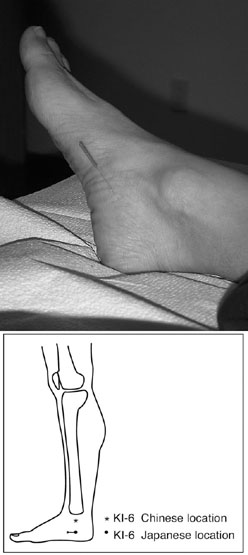Physicians of old have recognized the importance of tending the spirit in order to treat disease effectively. In particular, the Huang Di Nei Jing (Yellow Emperor’s Classic of Medicine), the oldest extant Chinese medical text (500 – 300 BC), states that in order to treat illness one must first establish contact with the patient’s spirit. This is certainly easier to do with a paradigm such as Oriental medicine, which sees no separation between the body, mind, and spirit, since they are viewed as inextricable components of the life force. However, the classical exhortation reminds us that the spirit is the motive force of the organism and must be reached first in order to initiate the healing process.
In Oriental medicine, the acupuncture needle is often seen as the instrument of contacting the spirit because the needles are inserted into discrete acupuncture points, each of which is said to control specific physiological functions of the body down to the cellular level—indeed, what we might think of as the innate wisdom or spirit of the body. Correspondingly, acupuncture points are named according to that spirit, but Oriental medicine also recognizes that before a practitioner can physically stick a needle into someone, another form of “spirit connecting” beyond the cellular level is essential as well. As most successful practitioners acknowledge, whether it is through guided imagery, eye contact, laughter, a smile, a handshake, or the ability to listen and be present for the patient, satisfying medicine for both the practitioner and the patient requires meaningful interaction—a deeper, soulful, spiritual encounter. The three treasures diagnostic paradigm reminds us that, of the three treasures—jing, qi, and shen — shen (spirit) must be treated first. It must be balanced, rooted, and secured before the manipulation of qi for it is indeed our core substrate, the motive force of the body and mind.
There are several ways to treat the spirit through needling acupuncture points with specific energetics. One particular approach that I have incorporated follows the ancient tenet that “Blood is the material basis of the human spirit.” The blood is the basis of our essence and of our mental and emotional activities. Thus, by regulating the blood, the spirit can be tangibly addressed.
Most acupuncture points treat the blood or the qi as the material basis of the yin and the yang. For ease of understanding and use, the following five points are amongst my favorite acupuncture points to treat the spirit by treating the blood. Their locations, energetics, and the specific needle techniques that can be used are discussed below.
 PC-6 Nei Guan (Inner Gate)
PC-6 Nei Guan (Inner Gate)
Location
Standard Chinese location. PC-6 can be found 2 cun above the transverse crease of the wrist between the tendons of the palmaris longus and flexor carpi radialis muscles.
Energetics
My favorite point in treating the blood is nei guan, PC-6. Pericardium 6 is the major point to move stagnant qi anywhere in the body, particularly in the upper burner. As such, it has the ability to decongest stagnant liver qi and to move the qi of the upper burner, thereby expanding the diaphragm, broadening the chest, and draining off excess stuck energy of the upper burner including stagnant emotional energy. Because the blood follows the qi, this point likewise moves the blood.
As a longitudinal luo point, Pericardium 6 regulates the qi and blood of the heart, opens the heart orifice, calms the spirit and the mind, and benefits the brain, the emotions, and the mental state.
Method
Puncture the point perpendicularly 0.5 to 1.0 in, or apply deep dispersive pressure to the point sevral times a day as needed. When using PC-6 as a longitudinal luo, needle the point obliquely 0.3 0.5 in in the distal direction (towards the fingers). Magnetic wrist bracelets (for sea sickness) worn on the point perform these functions well.
 KI-6 Zhao Hai (Shining Sea)
KI-6 Zhao Hai (Shining Sea)
Location
My preferred location of KI-6 is what is typically referred to as Japanese KI-6 (which is actually one of the alternative Chinese locations). This location is defined as 1 cun directly below the medial malleolus at the junction of the red and the white skin.
Energetics
KI-6 is my second favorite point of choice for assisting the spirit by treating the blood. Kidney 6 is perhaps to Japanese acupuncture what ST-36 (zu san li) is to Chinese acupuncture. It is the primary point to nourish the yin, a vital component of the blood. By nourishing yin, it calms the mind, cools the blood, strengthens the adrenal glands, and supports the sympathetic nervous system. It is useful for chronic illness, stress, and trauma, which typically have an emotional (spirit) component.
Method
Puncture the point with a #1 (or 36 gauge) 30mm needle transversely toward the heel, inserting it 0.1 to 0.2 in. Do not obtain qi on the point; simply insert it toward the heel. This is considered a tonification technique as it is inserted in the direction of the channel. See Figure 3.1a and b for illustration.

Stay updated, free articles. Join our Telegram channel

Full access? Get Clinical Tree





